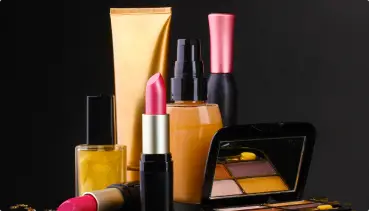Recent surveys show as many as 61 percent of people support the legalization of a substance once lauded as a “gateway drug,” tempting people to use harder and more deadly substances. Today, studies show that label might be misguided, and 30 states have legalized the use of medical marijuana, while nine have allowed its recreational use.
While the positive sentiment towards marijuana seems to be growing, one consideration might not be moving at the same pace: drug testing at work. To learn how industries are approaching marijuana use, we surveyed over 1,000 employees about their workplace testing policies. Read on to find out how common drug testing is (even in states that legally allow marijuana use) and how people feel about letting substances into their office space.

Making a Shift
When it comes to workplace drug testing, marijuana isn’t the only substance for which employers are keeping an eye out. Substance abuse at work has increased over the years, including the use of marijuana, cocaine, and methamphetamine.
Perhaps because organizations with no formal drug testing programs reported 30 to 40 percent higher drug use on average, 4 in 5 employees acknowledged working for companies with clearly defined substance use policies.
These policies have largely been unmoved by recent marijuana legalization. Sixty percent of people said their company stance on drug testing didn’t change after legalization, While another 21 percent said their employer did change the rules to exclude marijuana use once legalized, another 19 percent were unsure if or how their company’s substance use policy changed.
Across most industries, drug testing occurred pre-employment. However, among industries like government, construction, and retail, random drug testing was a relatively common practice. Some industries like technology and finance administered drug tests after an employee went on a vacation, while marketing and entertainment companies focused more on drug-related incidents.
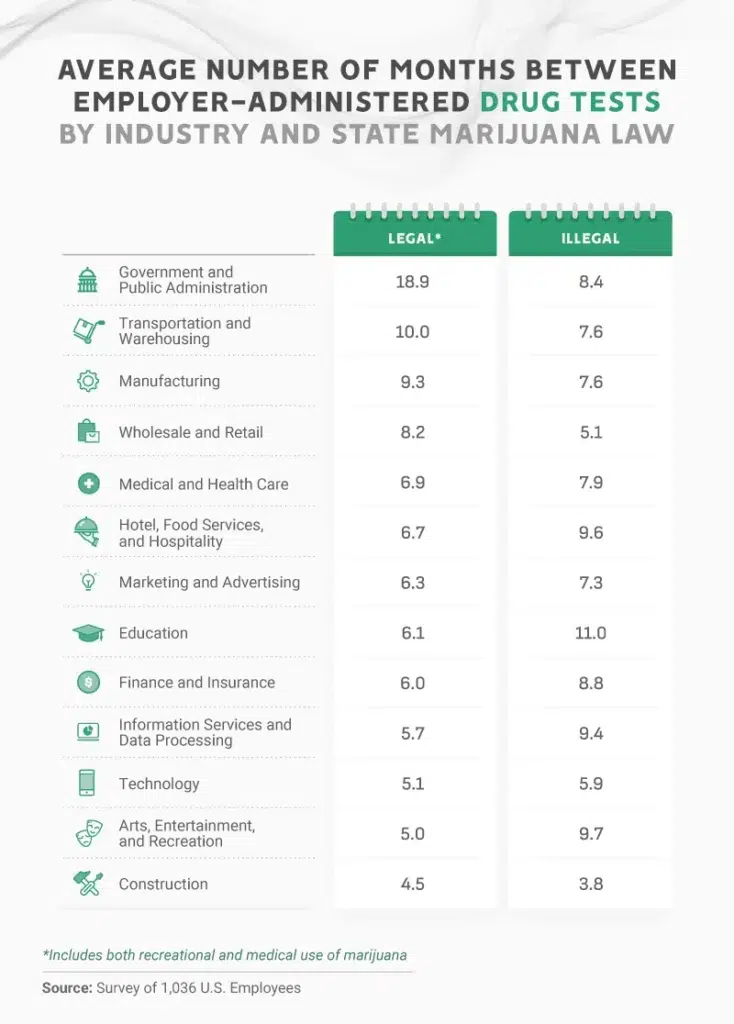
Prioritizing Drug Screenings
There are plenty of reasons for businesses to drug test regardless of state laws. Conversely, certain industries might put more pressure on their employees, which can cause higher rates of substance use.
While government jobs had the highest rate of pre-employment drug tests in states where marijuana was legal, they also had the longest gaps between screenings for substances that were both legal and illegal once hired. At almost 19 months between drug tests where marijuana is legal and more than 8 months where it’s illegal, there was an additional 8 months between screenings for government jobs and transportation and warehousing. In states where marijuana use was illegal, education-related employers went the longest between drug tests for illegal substances at 11 months.
In fact, it was employees working in construction, technology, and entertainment who were the most likely to be subjected to constant drug testing. On average, employers in these industries (in states where marijuana was legal) let between four and five months pass between drug screenings, random or otherwise.
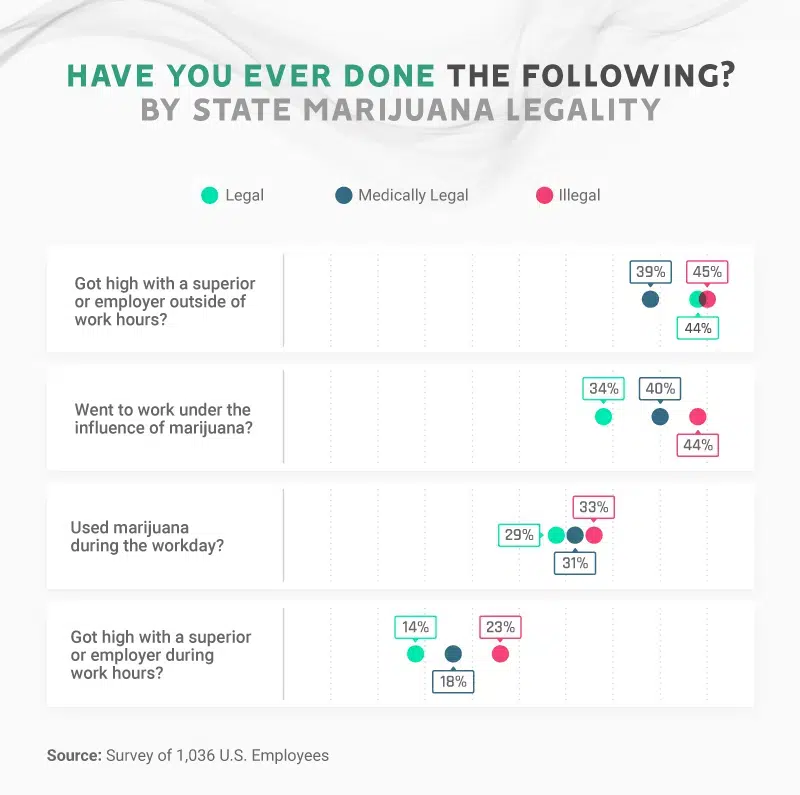
Changing With the Times
While acceptance of marijuana is picking up speed in the U.S., the effects of consumption aren’t necessarily positive. While some people might feel more relaxed or euphoric, there’s also a chance of experiencing fear, distrust, or even panic. Larger doses of marijuana can even lead to psychosis and hallucinations.
According to our survey, 45 percent of people living in states where marijuana was illegal got high with their employer outside of working hours, and 44 percent of people from the same states said they’d gone to work under the influence of marijuana. It was in states where marijuana was legal that employees were less likely to consume the substance in and around the workplace.
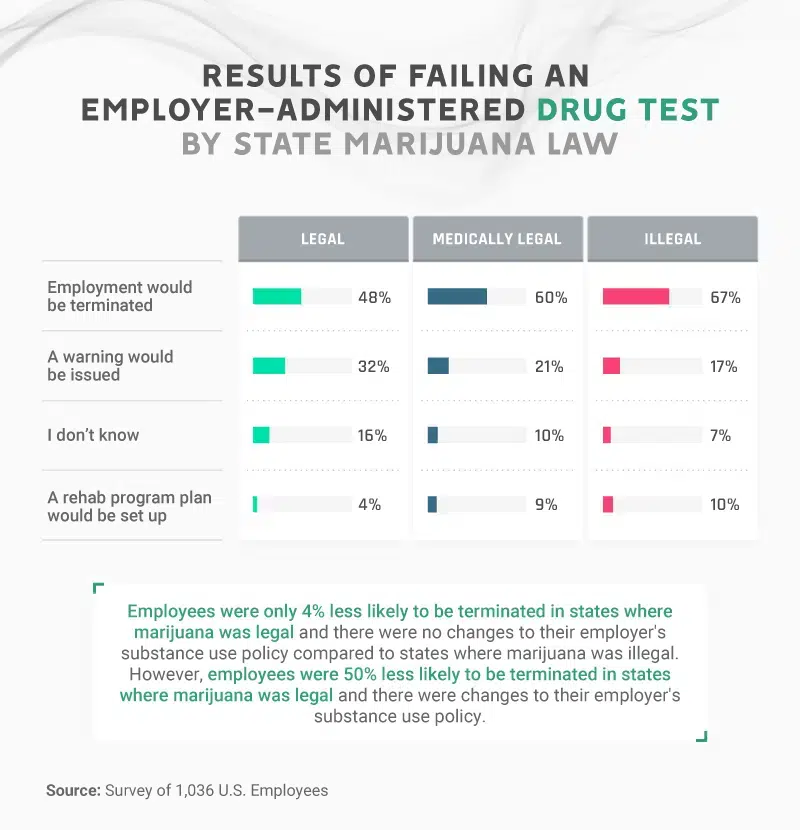
Failing a Drug Test
The legality of marijuana may also play a role in whether employees caught using it are terminated from their positions. Employees from states where marijuana was legal were almost 20 percent points less likely to be terminated after failing a drug test than those where marijuana was illegal.
But how to proceed after an employee fails a drug screening is still up to the company, regardless of state laws. There are no rules prohibiting businesses from being selective with employees or job candidates who smoke weed, even if it’s been prescribed for medicinal purposes. In legal states where employers didn’t change their substance use policies, failed drugs tests were only 4 percent less likely to result in termination than in states where marijuana was illegal. Among legal states with amended policies, the difference was 50 percent instead.
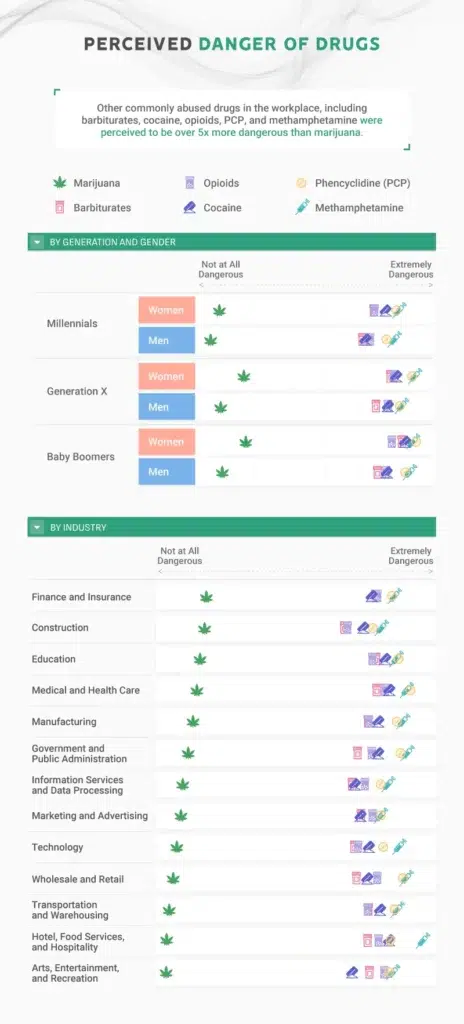
Understanding the Risks
Regardless of age, gender, or industry, employees were far less worried about the consumption of marijuana than they were about substances like meth, PCP, or cocaine.
Those working in entertainment, hospitality, retail, and transportation were the least concerned about the dangers of cannabis, although they were also the most likely to be frequently drug tested.
Because the drugs people are concerned about often have higher instances of addiction and overdose, drug testing may actually be a benefit to the work environment. In fact, drug testing could help employees by acting as a deterrent or by drawing attention to substance abuse issues.
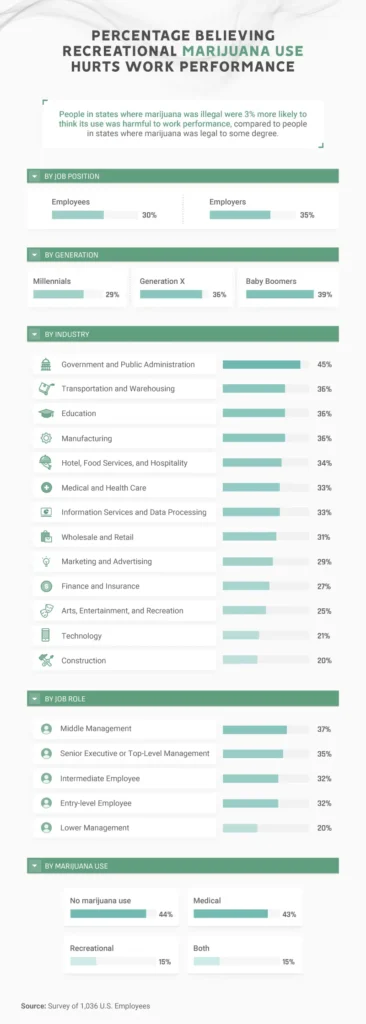
When Getting High Brings You Down
Just like having a hard drink on your lunch break or partaking in liquid libations during your next company event, there are many reasons why substances (including the legal ones) don’t necessarily mesh well in the workplace.
While a majority of people believe marijuana should be legal, 30 percent of employees and 35 percent of employers thought marijuana negatively affected work performance. Thirty-nine percent of baby boomers and 36 percent of Gen Xers had the same stance, compared to 29 percent of millennials.
Even 43 percent of people using marijuana for medicinal use – which studies show can help patients suffering from chronic pain, emotional and mental disorders, or terminal illnesses including cancer –admitted the substance wasn’t conducive to a high performing working environment.
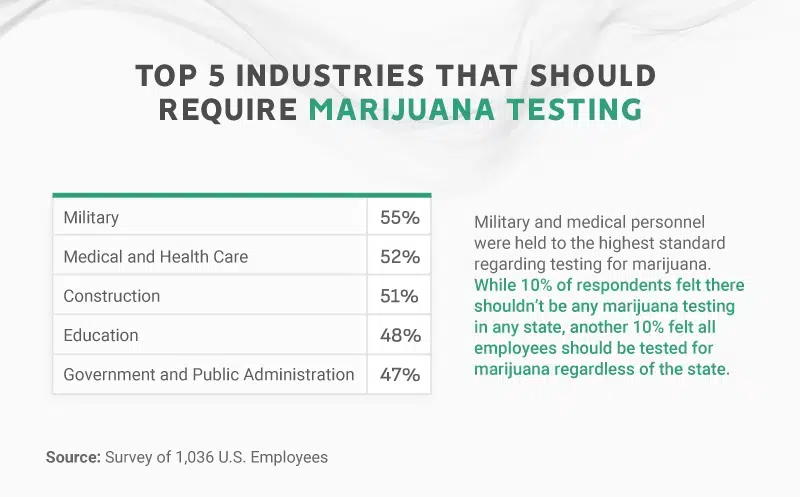
Perceptions of Drug Testing
Considering the changing laws, evolving public perception, and consequences for failing drug tests, is it still fair for companies to include marijuana as a prohibited substance?
Forty-three percent of employees using medical marijuana believed it was unacceptable for employers to administer drug tests in states where marijuana was legal. And while 35 percent using recreational marijuana said the same, 49 percent using recreational marijuana thought it was an acceptable course of action.
There were even job responsibilities people agreed that drug testing was acceptable for, including operating machinery (73 percent), operating a vehicle (66 percent), and supervising children (62 percent). Studies show that people who consume larger doses of marijuana tend to have natural dopamine deficiencies that can make them slow to respond and react to normal stimulations.
More than half of employees and employers agreed military professionals, health care practitioners, and people working in construction should be required to submit to drug testing regardless of state laws. Even in regions where both recreational and medicinal use is legal, failing a drug test for marijuana use can mean the end of your military career, although many branches of the armed forces no longer penalize recruits for having used marijuana in the past.
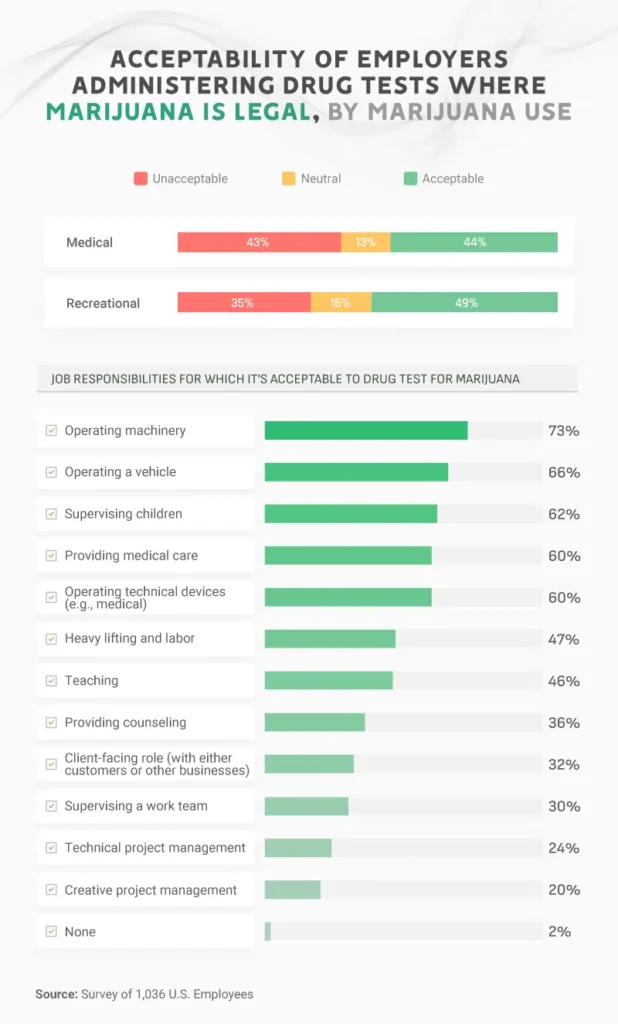
Navigating New Terrain
The landscape for legalized marijuana use has changed dramatically. But like drinking alcohol, just because it’s legal doesn’t mean you should do it on the job, and some companies are maintaining a hardline policy on what their employees can do even when they’re off the clock.
Some businesses still perform routine drug testing for marijuana, which can result in termination if detected. And as we found, a majority of people agree with this policy. While people were more forgiving of medical marijuana use, only 35 percent using recreational marijuana believed it was unacceptable for companies to drug test in states where marijuana was legal. As of right now, businesses maintain the right to discriminate against drug use, even when medical marijuana is involved.
Methodology
We collected responses from 1,036 U.S. employees from Amazon’s Mechanical Turk. 53.7 percent of our participants were men, and 46.3 percent were women. 79.2 percent of our participants were employees, and 20.8 percent were employers. 17.1 percent of our participants were entry-level employees, 40.4 percent were intermediate employees, 15.4 percent were lower management, 22.2 percent were middle management, and 5.0 percent were senior executives or top-level management. 7.5 percent of our participants were baby boomers, 25.7 percent were Gen Xers, and 66.8 percent were millennials.
3.7 percent of our participants worked in the arts, entertainment, and recreation industry, 4.8 percent in construction, 9.7 percent in education, 12.8 percent in finance and insurance, 6.6 percent in government and public administration, 5.9 percent in hotel, food services, and hospitality, 7.0 percent in information services and data processing, 8.7 percent in manufacturing, 3.1 percent in marketing and advertising, 15.4 percent in medical and healthcare, 7.5 percent in technology, 4.3 percent in transportation and warehousing, and 10.6 percent in wholesale and retail. 32.8 percent of our participants used marijuana recreationally, 9.7 percent used it medically, 11.1 percent used it both recreationally and medically, and 46.5 percent did not use marijuana at all. 19.7 percent of our participants worked in states where marijuana is legal recreationally and 46.1 percent in states where marijuana is illegal.
Participants ranged in age from 18 to 74 with a mean of 35.2 and a standard deviation of 10.5. Demographics that did not meet the minimum sample size were excluded from analysis.
Limitations
All of the information presented is self-reported data, which can cause issues like selective memory, telescoping, attribution, or exaggeration. This content was also not statistically tested and, therefore, is of an exploratory nature. Future research on the topic should approach it with more rigor.
Sources
- https://www.ncsl.org/health/state-medical-cannabis-laws
- https://www.pewresearch.org/short-reads/2019/11/14/americans-support-marijuana-legalization/
- https://nida.nih.gov/publications/research-reports/marijuana/marijuana-gateway-drug
- https://www.businessinsider.com/legal-marijuana-states-2018-1
- https://www.ehstoday.com/safety/article/21919044/workforce-drug-use-on-the-rise-infographic
- https://www.vice.com/en/article/53gvnb/why-do-people-use-drugs-at-work
- https://nida.nih.gov/publications/research-reports/marijuana/what-are-marijuana-effects
- https://www.vice.com/en/article/vdq3em/can-you-get-fired-for-smoking-legal-weed
- https://www.health.harvard.edu/blog/medical-marijuana-2018011513085
- https://www.liveabout.com/drink-at-work-events-1918788
- https://gizmodo.com.au/2020/10/why-smoking-a-bowl-makes-you-tired-and-lazy/
- https://www.npr.org/2018/01/16/578422469/how-active-duty-military-are-navigating-changing-attitudes-toward-marijuana
- https://smallbusiness.chron.com/employee-urine-drug-tests-normally-test-for-18114.html
- https://archives.nida.nih.gov/publications/media-guide/most-commonly-used-addictive-drugs
Fair Use Statement
Want to further discuss drug testing in the workplace? We welcome the reposting of our study findings and any related graphics or design for non-commercial use. If you decide to share this content, simply include a link back to this page so that your readers have access to the entirety of our findings.


